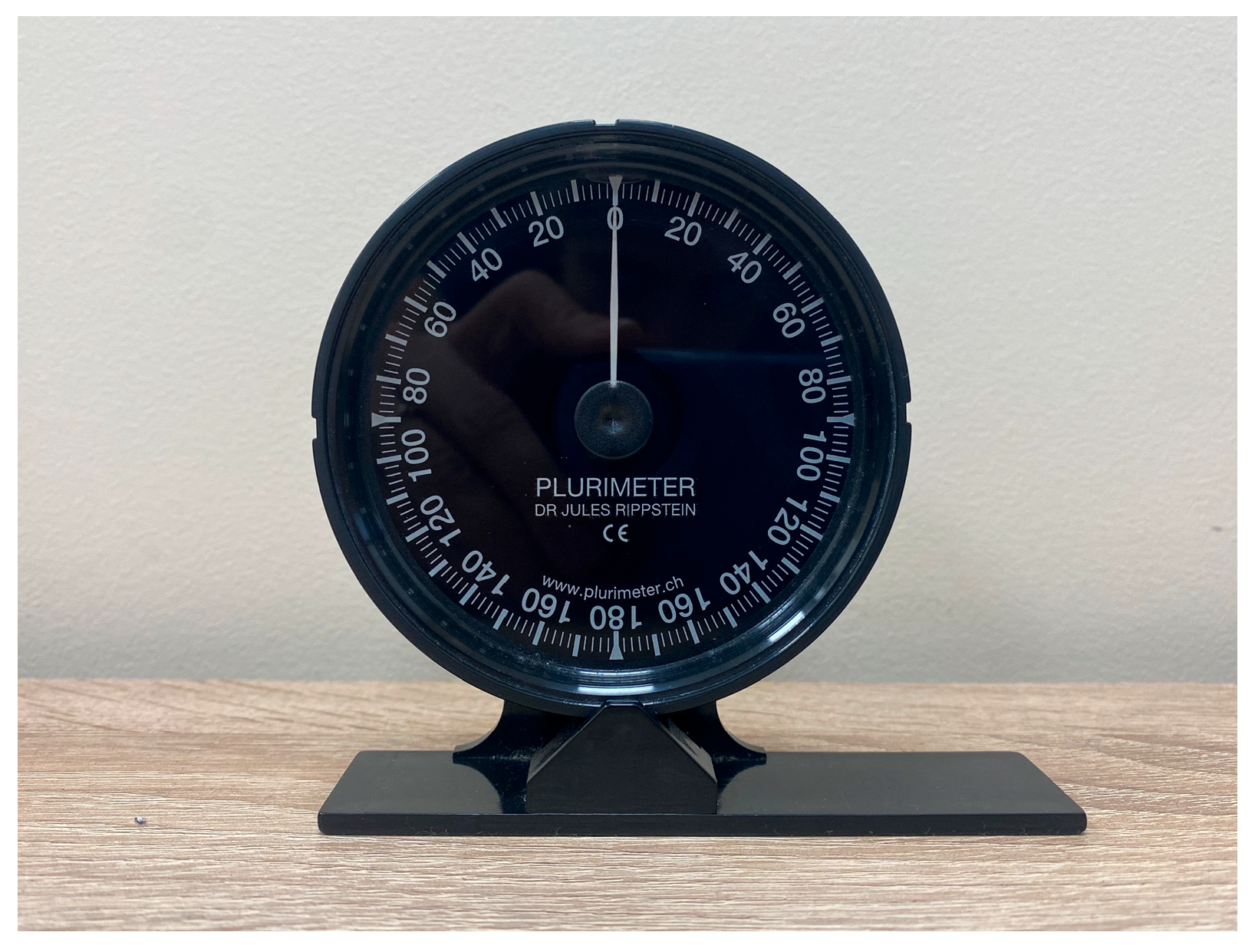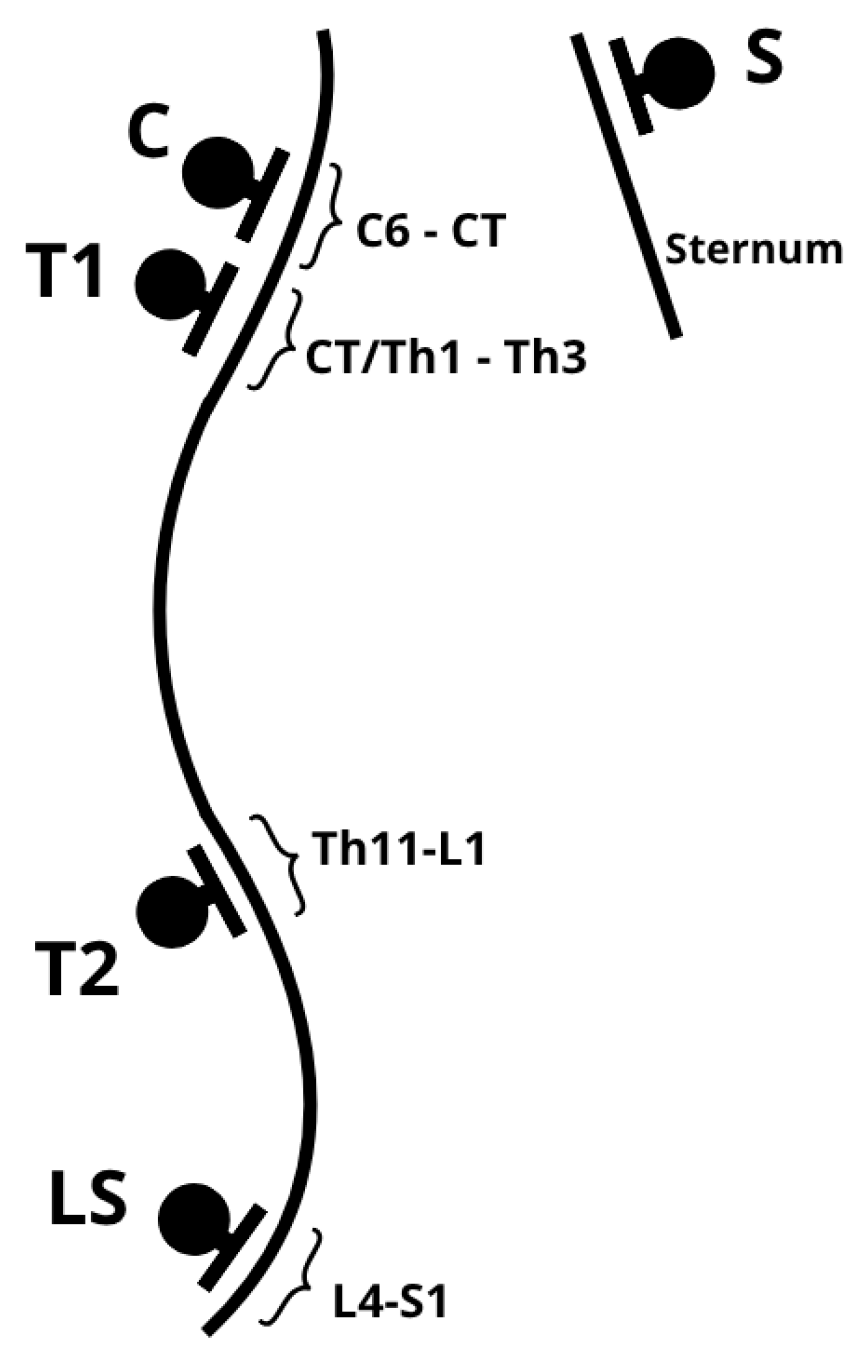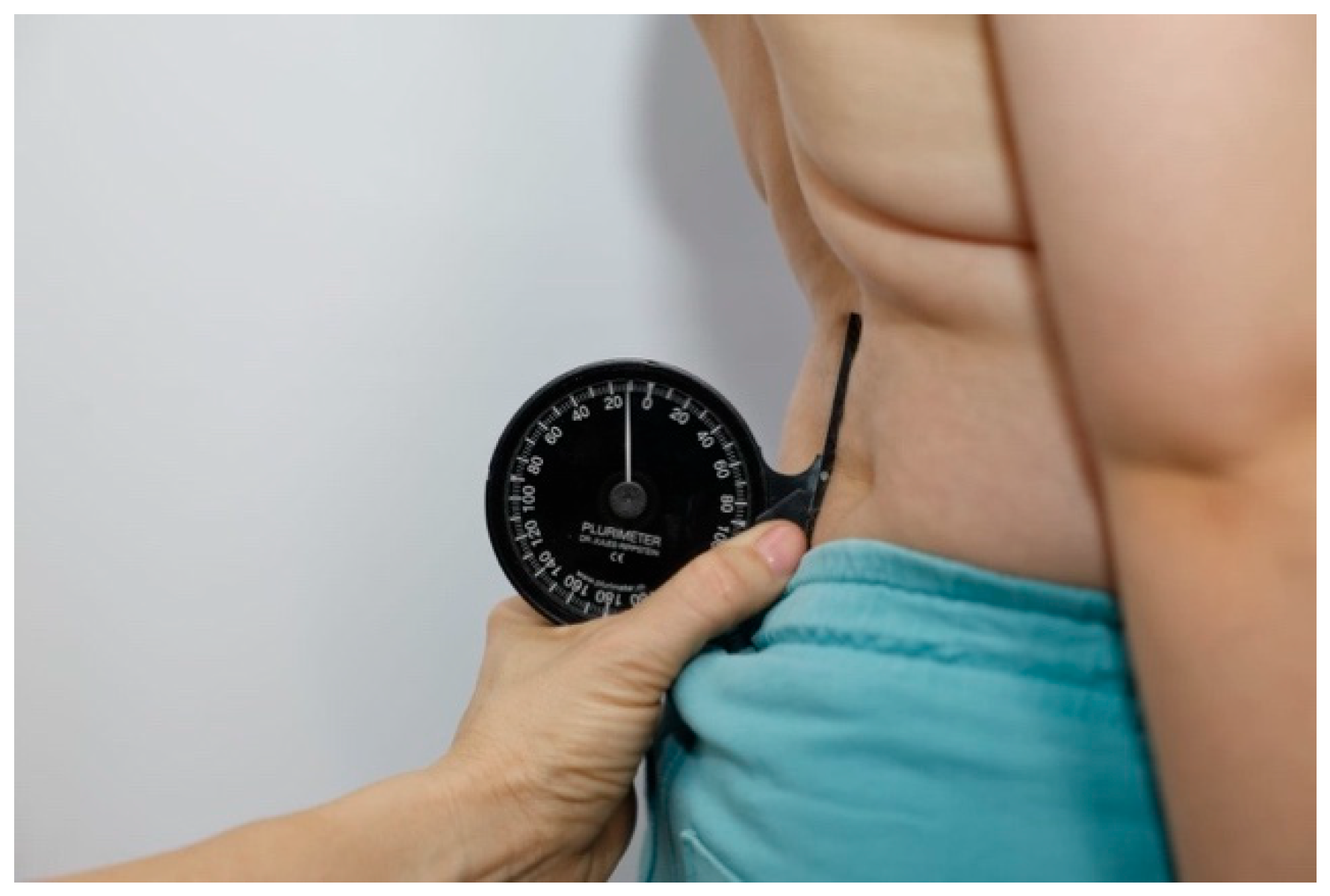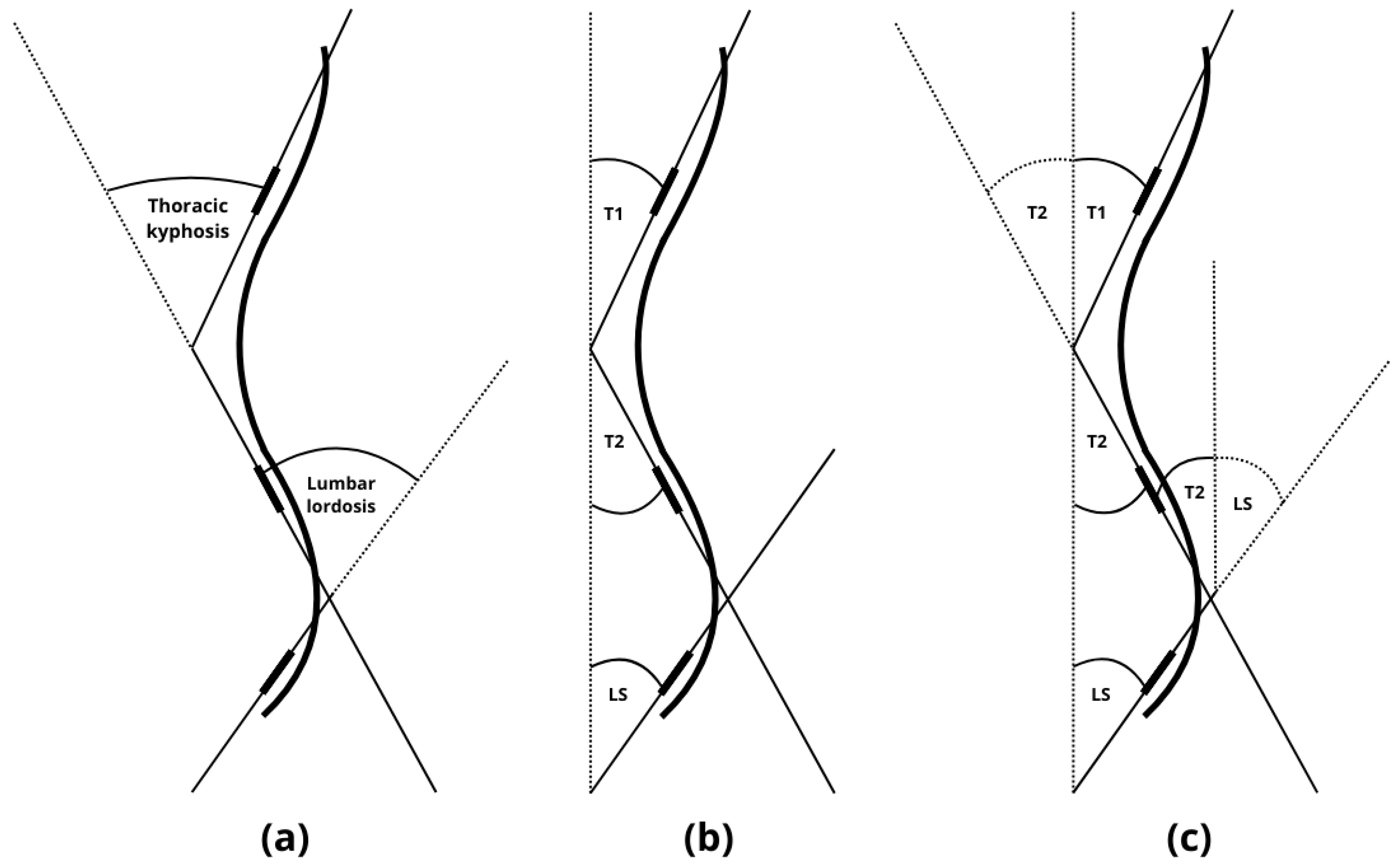Spinal Sagittal Alignment Assessment and Hip Range of Motion in Ambulatory Boys with Duchenne Muscular Dystrophy: Reliability, Diagnosis and Implications for Physiotherapy Management
Abstract
1. Introduction
- To assess inter- and intra-rater reliability of sagittal spinal curvature measurements in ambulant boys with DMD.
- To compare sagittal spinal curvature between boys with DMD and healthy peers.
- To analyze the effect of lower limb positioning (parallel vs. feet together) on sagittal spinal alignment in boys with DMD.
- To examine the relationship between hip adduction/extension range and sagittal spinal alignment in boys with DMD, and compare hip joint mobility between the DMD and control groups.
2. Materials and Methods
2.1. Study Design and Ethical Approval
2.2. Participants
2.3. Measurement Procedures
2.4. Statistical Analysis
3. Results
3.1. Reliability of Spinal Curvature Measurements with the Rippstein Plurimeter
3.2. Comparison of Sagittal Spinal Alignment Between the DMD and Control Groups
3.3. Effect of Lower Limb Position on Sagittal Spinal Alignment in Boys with DMD (Position 1: Parallel Legs vs. Position 2: Feet Together with Hip Adduction)
Comparison of Sagittal Spinal Alignment by Age in the DMD and Control Groups
3.4. Hip Joint Range of Motion and Correlation with Sagittal Spinal Alignment
4. Discussion
4.1. Measurement Reliability
4.2. Increased Lumbar Lordosis
4.3. Hip Adduction Increases Anterior Pelvic Tilt and Lordosis
4.4. Hip Range of Motion Decreases with Age
4.5. Correlations
4.6. Study Limitations
5. Conclusions
Author Contributions
Funding
Institutional Review Board Statement
Informed Consent Statement
Data Availability Statement
Acknowledgments
Conflicts of Interest
References
- Birnkrant, D.J.; Bushby, K.; Bann, C.M.; Apkon, S.D.; Blackwell, A.; Brumbaugh, D.; Case, L.E.; Clemens, P.R.; Hadjiyannakis, S.; Pandya, S.; et al. Diagnosis and management of Duchenne muscular dystrophy, part 1: Diagnosis, and neuromuscular, rehabilitation, endocrine, and gastrointestinal and nutritional management. Lancet Neurol. 2018, 17, 251–267. [Google Scholar] [CrossRef]
- Crisafulli, S.; Sultana, J.; Fontana, A.; Salvo, F.; Messina, S.; Trifirò, G. Global epidemiology of Duchenne muscular dystrophy: An updated systematic review and meta-analysis. Orphanet J. Rare Dis. 2020, 15, 141. [Google Scholar] [CrossRef] [PubMed]
- Duan, D.; Goemans, N.; Takeda, S.I.; Mercuri, E.; Aartsma-Rus, A. Duchenne muscular dystrophy. Nat. Rev. Dis. Primers 2021, 7, 13. [Google Scholar]
- Case, L.E.; Apkon, S.D.; Eagle, M.; Gulyas, A.; Juel, L.; Matthews, D.; Newton, R.A.; Posselt, H.F. Rehabilitation management of the patient with Duchenne muscular dystrophy. Pediatrics 2018, 142 (Suppl. 2), S17–S33. [Google Scholar] [CrossRef]
- Filiz, M.B.; Toraman, N.F.; Kutluk, M.G.; Filiz, S.; Doğan, Ş.K.; Çakır, T.; Yaman, A. Effects of lumbar lordosis increment on gait deteriorations in ambulant boys with Duchenne muscular dystrophy: A cross-sectional study. Braz. J. Phys. Ther. 2021, 25, 749–755. [Google Scholar] [CrossRef]
- D’Angelo, M.G.; Berti, M.; Piccinini, L.; Romei, M.; Guglieri, M.; Bonato, S.; Degrate, A.; Turconi, A.C.; Bresolin, N. Gait pattern in Duchenne muscular dystrophy. Gait Posture 2009, 29, 36–41. [Google Scholar] [CrossRef]
- Kostera-Pruszczyk, A. Glikokortykoidy w leczeniu dystrofii mięśniowej Duchenne’a–standard postępowania. Neurol. Dziec. 2011, 20, 11–14. [Google Scholar]
- Chung, N.-S.; Jeon, C.-H.; Lee, H.-D.; Won, S.-H. Measurement of spinopelvic parameters on standing lateral lumbar radiographs: Validity and reliability. Clin. Spine Surg. 2017, 30, E119–E123. [Google Scholar] [CrossRef]
- Knott, P.; Pappo, E.; Cameron, M.; Demauroy, J.; Rivard, C.; Kotwicki, T.; Zaina, F.; Wynne, J.; Stikeleather, L.; Bettany-Saltikov, J.; et al. SOSORT 2012 consensus paper: Reducing X-ray exposure in pediatric patients with scoliosis. Scoliosis 2014, 9, 4. [Google Scholar] [CrossRef]
- Kluszczynski, M.; Czernicki, J.; Kubacki, J. The plurimetric assessment of spinal curvature changes in the sagittal plane in children and youths, measured during 10 years’ observation. Postepy Rehabil. 2013, 27, 1. [Google Scholar] [CrossRef]
- Stępień, A.; Pałdyna, B. Neurodynamic functions and their correlations with postural parameters in adolescents with idiopathic scoliosis. J. Clin. Med. 2022, 11, 1115. [Google Scholar] [CrossRef] [PubMed]
- Stępień, A.; Jędrzejowska, M.; Guzek, K.; Rekowski, W.; Stępowska, J. Reliability of four tests to assess body posture and the range of selected movements in individuals with spinal muscular atrophy. BMC Musculoskelet. Disord. 2019, 20, 54. [Google Scholar] [CrossRef]
- Stępień, A.; Mazurkiewicz, Ł.; Maślanko, K.; Rekowski, W.; Jędrzejowska, M. Cervical rotation, chest deformity and pelvic obliquity in patients with spinal muscular atrophy. BMC Musculoskelet. Disord. 2020, 21, 726. [Google Scholar] [CrossRef]
- Malliaras, P.; Hogan, A.; Nawrocki, A.; Crossley, K.; Schache, A. Hip flexibility and strength measures: Reliability and association with athletic groin pain. Br. J. Sports Med. 2009, 43, 739–744. [Google Scholar] [CrossRef] [PubMed]
- Kemp, J.L.; Makdissi, M.; Schache, A.G.; Finch, C.F.; Pritchard, M.G.; Crossley, K.M. Is quality of life following hip arthroscopy in patients with chondrolabral pathology associated with impairments in hip strength or range of motion? Knee Surg. Sports Traumatol. Arthrosc. 2016, 24, 3955–3961. [Google Scholar] [CrossRef]
- Kuraczowska, K.; Ligarska, K. Aktywność fizyczna a skrócenia czynnościowe mięśni kończyn dolnych dziewcząt w wieku 14–16 lat. Physiotherapy/Fizjoterapia 2014, 22, 18. [Google Scholar]
- Stępień, A.; Sikora-Chojak, J.; Maślanko, K.; Kiebzak, W. Hip abduction and supported standing affect the ranges of hips extension in spinal muscular atrophy patients. Pol. Ann. Med. 2021, 28, 50. [Google Scholar] [CrossRef]
- Koo, T.K.; Li, M.Y. A guideline of selecting and reporting intraclass correlation coefficients for reliability research. J. Chiropr. Med. 2016, 15, 155–163. [Google Scholar] [CrossRef] [PubMed]
- Sutherland, D.H.; Olshen, R.; Cooper, L.; Wyatt, M.; Leach, J.; Mubarak, S.; Schultz, P. The pathomechanics of gait in Duchenne muscular dystrophy. Dev. Med. Child. Neurol. 1981, 23, 3–22. [Google Scholar] [CrossRef]
- Wnuk, B.; Kroczek, W.; Kroczek, E.; Durmała, J. Maintaining body posture in the modified Matthias test depending on sex and the physical activity level in the population of young people—Preliminary research. Forum Reumatol. 2023, 9, 169–174. [Google Scholar] [CrossRef]
- Grabara, M.; Witkowska, A. Sagittal spinal curvatures of young adults in the context of their self-reported physical activity and somatic parameters. Sci. Rep. 2024, 14, 12221. [Google Scholar] [CrossRef]
- Grabara, M. Effects of 8-months yoga training on shaping the spine in people over 55. Biomed. Hum. Kinet. 2013, 5, 59–64. [Google Scholar] [CrossRef]
- Stoliński, Ł.; Czaprowski, D.; Kozinoga, M.; Kotwicki, T. Clinical measurement of sagittal trunk curvatures: Photographic angles versus Rippstein plurimeter angles in healthy school children. Scoliosis 2014, 9 (Suppl. 1), O15. [Google Scholar] [CrossRef]
- Stolinski, L.; Kozinoga, M.; Czaprowski, D.; Tyrakowski, M.; Cerny, P.; Suzuki, N.; Kotwicki, T. Two-dimensional digital photography for child body posture evaluation: Standardized technique, reliable parameters and normative data for age 7–10 years. Scoliosis Spinal Disord. 2017, 12, 38. [Google Scholar] [CrossRef] [PubMed]
- Baptista, C.R.; Costa, A.A.; Pizzato, T.M.; Souza, F.B.; Mattiello-Sverzut, A.C. Postural alignment in children with Duchenne muscular dystrophy and its relationship with balance. Braz. J. Phys. Ther. 2014, 18, 119–126. [Google Scholar] [CrossRef]
- Vandekerckhove, I.; Papageorgiou, E.; Hanssen, B.; De Beukelaer, N.; Hauwe, M.V.D.; Goemans, N.; Van Campenhout, A.; De Waele, L.; De Groote, F.; Desloovere, K. Gait classification for growing children with Duchenne muscular dystrophy. Sci. Rep. 2024, 14, 10828. [Google Scholar] [CrossRef]
- Romano, A.; Favetta, M.; Schirinzi, T.; Summa, S.; Minosse, S.; D’AMico, A.; Catteruccia, M.; Petrarca, M.; Castelli, E.; Bertini, E.; et al. Evaluation of gait in Duchenne muscular dystrophy: Relation of 3D gait analysis to clinical assessment. Neuromuscul. Disord. 2019, 29, 920–929. [Google Scholar] [CrossRef]
- Doglio, L.; Pavan, E.; Pernigotti, I.; Petralia, P.; Frigo, C.; Minetti, C. Early signs of gait deviation in Duchenne muscular dystrophy. Eur. J. Phys. Rehabil. Med. 2011, 47, 587–594. [Google Scholar]
- Willcocks, R.J.; Barnard, A.M.; Wortman, R.J.; Senesac, C.R.; Lott, D.J.; Harrington, A.T.; Zilke, K.L.; Forbes, S.C.; Rooney, W.D.; Wang, D.-J.; et al. Development of contractures in DMD in relation to MRI-determined muscle quality and ambulatory function. J. Neuromuscul. Dis. 2022, 9, 289–302. [Google Scholar] [CrossRef]
- Choi, Y.A.; Chun, S.M.; Kim, Y.; Shin, H.I. Lower extremity joint contracture according to ambulatory status in children with Duchenne muscular dystrophy. BMCMusculoskelet. Disord. 2018, 19, 287. [Google Scholar] [CrossRef]
- Vandekerckhove, I.; Hauwe, M.V.D.; Dewit, T.; Molenberghs, G.; Goemans, N.; De Waele, L.; Van Campenhout, A.; De Groote, F.; Desloovere, K.; Bardhan, M. Longitudinal trajectories of muscle impairments in growing boys with Duchenne muscular dystrophy. PLoS ONE 2025, 20, e0307007. [Google Scholar]
- Gaudreault, N.; Gravel, D.; Nadeau, S.; Houde, S.; Gagnon, D. Gait patterns comparison of children with Duchenne muscular dystrophy to those of control subjects considering the effect of gait velocity. Gait Posture 2010, 32, 342–347. [Google Scholar] [CrossRef] [PubMed]
- Boccardi, S.; Gabardi, C.; Negrini, A.; Santambrogio, G.C. Locomotor and posture strategies in patients with Duchenne Muscular Dystrophy (DMD): Part I. Gait analysis. Eur. Medicophys. 1997, 33, 13–22. [Google Scholar]
- Vandekerckhove, I.; Hauwe, M.V.D.; De Beukelaer, N.; Stoop, E.; Goudriaan, M.; Delporte, M.; Molenberghs, G.; Van Campenhout, A.; De Waele, L.; Goemans, N.; et al. Longitudinal alterations in gait features in growing children with Duchenne muscular dystrophy. Front. Hum. Neurosci. 2022, 16, 861136. [Google Scholar] [CrossRef] [PubMed]
- Akkurt, L.; Alemdaroğlu Gürbüz, İ.; Karaduman, A.; Tunca Yilmaz, Ö. Lower limb flexibility in children with Duchenne muscular dystrophy: Effects on functional performance. Pediatr. Exerc. Sci. 2019, 31, 42–46. [Google Scholar] [CrossRef] [PubMed]
- Uğur, F.; Gürbüz, İ.; Köken, Ö.Y.; Kurt, A.N.Ç.; Yılmaz, Ö. Pelvic obliquity, trunk control, and motor function: An exploratory study in a non-ambulatory Duchenne muscular dystrophy cohort. Rev. Assoc. Med. Bras. 2024, 70, e20241109. [Google Scholar]
- Hunter, D.J.; Rivett, D.; McKiernan, S.; Weerasekara, I.; Snodgrass, S.J. Is the inclinometer a valid measure of thoracic kyphosis? A cross-sectional study. Braz. J. Phys. Ther. 2018, 22, 310–317. [Google Scholar] [CrossRef]
- Barrett, E.; Lenehan, B.; O’sullivan, K.; Lewis, J.; McCreesh, K. Validation of the manual inclinometer and flexicurve for the measurement of thoracic kyphosis. Physiother. Theory Pract. 2017, 34, 301–308. [Google Scholar] [CrossRef]




| Parameter | Interobserver Reliability | Intraobserver Reliability | ||||
|---|---|---|---|---|---|---|
| ICC | 95% Confidence Interval | p | ICC | 95% Confidence Interval | p | |
| Sternum | 0.947 | 0.910–0.970 | <0.001 | 0.939 | 0.888–0.967 | <0.001 |
| C | 0.897 | 0.825–0.942 | <0.001 | 0.878 | 0.781–0.934 | <0.001 |
| T1 | 0.972 | 0.951–0.984 | <0.001 | 0.947 | 0.904–0.972 | <0.001 |
| T2 | 0.915 | 0.857–0.952 | <0.001 | 0.867 | 0.761–0.928 | <0.001 |
| LS | 0.957 | 0.928–0.976 | <0.001 | 0.953 | 0.914–0.975 | <0.001 |
| DMD (n = 42) | CG (n = 36) | DMD vs. CG | |||||
|---|---|---|---|---|---|---|---|
| Parameter | Mean ± SD | Median | Range | Mean | Median | Range | p |
| Age (years) | 7.98 ± 2.57 | 8.00 | 5.00–14.00 | 8.10 ± 2.32 | 8.00 | 5.00–12.5 | 0.651 |
| Body weight (kg) | 27.99 ± 8.84 | 26.00 | 16.50–51.00 | 31.15 ± 10.68 | 28.00 | 19.00–55.00 | 0.176 |
| Body height (cm) | 124.00 ± 11.88 | 124.00 | 102.00–152.00 | 134.87 ± 15.31 | 132.5 | 112.00–168.00 | 0.002 |
| BMI (kg/m2) | 17.73 ± 2.69 | 17.20 | 12.93–24.33 | 16.71 ± 2.49 | 15.91 | 13.88–21.37 | 0.037 |
| Steroid treatment | 30/42 (71.4%) | - | - | - | - | - | - |
| Scoliosis | 6/42 (14.3%) | - | - | - | - | - | - |
| Ability to walk up stairs | 37/42 (88.1%) | - | - | - | - | - | - |
| Number of falls per week | 35/42 (83.3%) | 2 | 1–35 | - | - | - | - |
| Physical therapy | 40/42 (95.2%) | 3 | 1–5 | - | - | - | - |
| Position 1: Standing-feet in line with hip joints | |||||||
| Sternum (°) | 32.38 ± 8.96 | 32.00 | 12.00–52.00 | 27.25 ± 4.65 | 26.5 | 20.00–38.00 | 0.002 |
| C (°) | 17.02 ± 7.15 | 18.00 | 0.00–30.00 | 19.39 ± 3.14 | 20.00 | 10.00–26.00 | 0.017 |
| T1 (°) | 10.90 ± 8.96 | 10.00 | −15.00–32.00 | 11.33 ± 3.80 | 10.00 | 4.00–20.00 | 0.792 |
| T2 (°) | 13.48 ± 6.62 | 13.00 | 0.00–28.00 | 11.55 ± 3.51 | 10.00 | 4.00–20.00 | 0.120 |
| LS (°) | 23.76 ± 8.71 | 24.00 | 10.00–48.00 | 18.61 ± 4.99 | 20.00 | 6.00–26.00 | 0.004 |
| Thoracic kyphosis (°) | 24.38 ± 8.82 | 24.00 | −6.00–52.00 | 23.14 ± 5.37 | 22.00 | 14.00–36.00 | 0.570 |
| Lumbar lordosis (°) | 37.24 ± 11.45 | 36.00 | 20.00–70.00 | 30.36 ± 6.33 | 31.00 | 18.00–44.00 | 0.005 |
| HEL | 14.50 ± 8.03 | 17.00 | −8.00–26.00 | 18.94 ± 4.21 | 20.00 | 4.00–26.00 | 0.024 |
| HER | 14.26 ± 6.55 | 12.00 | 0.00–26.00 | 17.83 ± 5.10 | 20.00 | 4.00–26.00 | 0.352 |
| HADL | 28.67 ± 8.53 | 30.00 | 8.00–40.00 | 36.33 ± 3.11 | 36.00 | 28.00–40.00 | <0.001 |
| HADR | 29.14 ± 8.53 | 30.00 | 10.00–40.00 | 36.61 ± 2.92 | 36.50 | 28.00–42.00 | <0.001 |
| Position 1 Feet in line with hip joints | Position 2 Feet together | Position 1 vs. Position 2 | |||||
|---|---|---|---|---|---|---|---|
| Parameter | Mean ± SD | Median | Range | Mean ± SD | Median | Range | p |
| Sternum (°) | 32.38 ± 8.96 | 32.00 | 12.00–52.00 | 33.38 ± 8.04 | 34.00 | 18.00–50.00 | 0.067 |
| C (°) | 17.02 ± 7.15 | 18.00 | 0.00–30.00 | 15.79 ± 7.38 | 16.00 | 0.00–30.00 | 0.069 |
| T1 (°) | 10.90 ± 8.96 | 10.00 | −15.00–32.00 | 7.67 ± 10.74 | 9.00 | −15.00–40.00 | <0.001 |
| T2 (°) | 13.48 ± 6.62 | 13.00 | 0.00–28.00 | 16.43 ± 7.00 | 16.00 | 2.00–30.00 | 0.001 |
| LS (°) | 23.76 ± 8.71 | 24.00 | 10.00–48.00 | 28.07 ± 10.19 | 25.50 | 10.00–52.00 | <0.001 |
| Thoracic kyphosis (°) | 24.38 ± 8.82 | 24.00 | −6.00–52.00 | 23.43 ± 10.12 | 22.00 | −6.00–52.00 | 0.535 |
| Lumbar lordosis (°) | 37.24 ± 11.45 | 36.00 | 20.00–70.00 | 44.50 ± 13.26 | 43.00 | 22.00–74.00 | <0.001 |
| Age | Height | Weight | S | C | T1 | T2 | LS | K | L | |
|---|---|---|---|---|---|---|---|---|---|---|
| S | 0.110 | 0.127 | 0.305 * | - | −0.629 ** | −0.593 ** | 0.578 ** | 0.066 | −0.238 | 0.422 ** |
| p | 0.488 | 0.423 | 0.050 | 0.000 | 0.000 | 0.000 | 0.678 | 0.129 | 0.005 | |
| C | 0.089 | 0.086 | 0.017 | −0.629 ** | - | 0.675 ** | −0.307 * | −0.050 | 0.516 ** | −0.246 |
| 0.574 | 0.589 | 0.917 | 0.000 | 0.000 | 0.048 | 0.753 | 0.000 | 0.116 | ||
| T1 | −0.081 | −0.099 | −0.153 | −0.593 ** | 0.675 ** | - | −0.405 ** | −0.488 ** | 0.676 ** | −0.612 ** |
| 0.611 | 0.532 | 0.333 | 0.000 | 0.000 | 0.008 | 0.001 | 0.000 | 0.000 | ||
| T2 | 0.268 | 0.269 | 0.300 | 0.578 ** | −0.307 * | −0.405 ** | - | 0.087 | 0.337 * | 0.678 ** |
| 0.086 | 0.085 | 0.054 | 0.000 | 0.048 | 0.008 | 0.582 | 0.029 | 0.000 | ||
| LS | 0.425 ** | 0.355 * | 0.345 * | 0.066 | −0.050 | −0.488 ** | 0.087 | - | −0.404 ** | 0.772 ** |
| 0.005 | 0.021 | 0.025 | 0.678 | 0.753 | 0.001 | 0.582 | 0.008 | 0.000 | ||
| K | 0.167 | 0.126 | 0.064 | −0.238 | 0.516 ** | 0.676 ** | 0.337 * | −0.404 ** | - | −0.098 |
| 0.289 | 0.426 | 0.688 | 0.129 | 0.000 | 0.000 | 0.029 | 0.008 | 0.538 | ||
| L | 0.504 ** | 0.457 ** | 0.480 ** | 0.422 ** | −0.246 | −0.612 ** | 0.678 ** | 0.772 ** | −0.098 | - |
| 0.001 | 0.002 | 0.001 | 0.005 | 0.116 | 0.000 | 0.000 | 0.000 | 0.538 | ||
| HEL | −0.476 ** | −0.395 ** | −0.324 * | 0.053 | −0.049 | 0.070 | −0.180 | −0.294 | −0.137 | −0.287 |
| 0.001 | 0.010 | 0.037 | 0.741 | 0.760 | 0.658 | 0.253 | 0.059 | 0.388 | 0.066 | |
| HER | −0.350 * | −0.186 | −0.134 | 0.087 | −0.122 | 0.024 | −0.077 | −0.309 * | −0.087 | −0.224 |
| 0.023 | 0.239 | 0.398 | 0.582 | 0.443 | 0.881 | 0.627 | 0.047 | 0.583 | 0.155 | |
| HADL | −0.564 ** | −0.408 ** | −0.300 | −0.015 | 0.018 | 0.019 | −0.175 | −0.340 * | −0.076 | −0.334 * |
| 0.000 | 0.007 | 0.053 | 0.927 | 0.911 | 0.906 | 0.267 | 0.027 | 0.634 | 0.031 | |
| HADR | −0.513 ** | −0.349 * | −0.267 | −0.218 | 0.115 | 0.222 | −0.322 * | −0.411 ** | 0.019 | −0.466 ** |
| 0.001 | 0.023 | 0.088 | 0.166 | 0.469 | 0.158 | 0.037 | 0.007 | 0.907 | 0.002 |
Disclaimer/Publisher’s Note: The statements, opinions and data contained in all publications are solely those of the individual author(s) and contributor(s) and not of MDPI and/or the editor(s). MDPI and/or the editor(s) disclaim responsibility for any injury to people or property resulting from any ideas, methods, instructions or products referred to in the content. |
© 2025 by the authors. Licensee MDPI, Basel, Switzerland. This article is an open access article distributed under the terms and conditions of the Creative Commons Attribution (CC BY) license (https://creativecommons.org/licenses/by/4.0/).
Share and Cite
Stępień, A.; Maślanko, K.; Kruk-Majtyka, W.; Gargas, G. Spinal Sagittal Alignment Assessment and Hip Range of Motion in Ambulatory Boys with Duchenne Muscular Dystrophy: Reliability, Diagnosis and Implications for Physiotherapy Management. Healthcare 2025, 13, 2392. https://doi.org/10.3390/healthcare13192392
Stępień A, Maślanko K, Kruk-Majtyka W, Gargas G. Spinal Sagittal Alignment Assessment and Hip Range of Motion in Ambulatory Boys with Duchenne Muscular Dystrophy: Reliability, Diagnosis and Implications for Physiotherapy Management. Healthcare. 2025; 13(19):2392. https://doi.org/10.3390/healthcare13192392
Chicago/Turabian StyleStępień, Agnieszka, Katarzyna Maślanko, Weronika Kruk-Majtyka, and Grzegorz Gargas. 2025. "Spinal Sagittal Alignment Assessment and Hip Range of Motion in Ambulatory Boys with Duchenne Muscular Dystrophy: Reliability, Diagnosis and Implications for Physiotherapy Management" Healthcare 13, no. 19: 2392. https://doi.org/10.3390/healthcare13192392
APA StyleStępień, A., Maślanko, K., Kruk-Majtyka, W., & Gargas, G. (2025). Spinal Sagittal Alignment Assessment and Hip Range of Motion in Ambulatory Boys with Duchenne Muscular Dystrophy: Reliability, Diagnosis and Implications for Physiotherapy Management. Healthcare, 13(19), 2392. https://doi.org/10.3390/healthcare13192392






